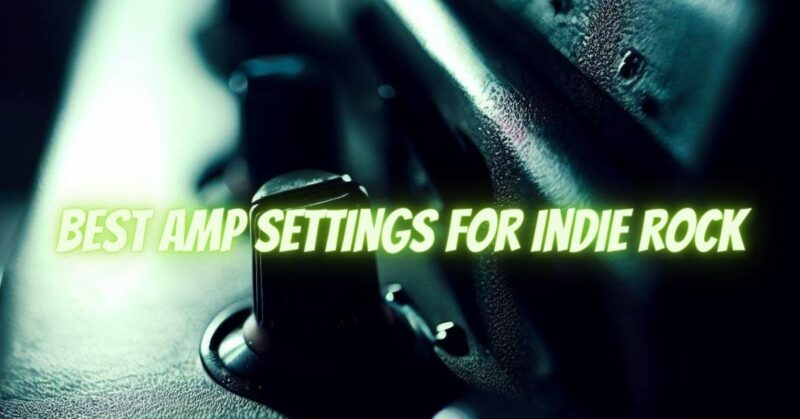Indie rock is a genre known for its distinctive and eclectic sound, combining elements of rock, pop, and alternative music. To capture the essence of indie rock and create a sonic landscape that’s both captivating and unique, dialing in the right amp settings is essential. In this article, we’ll delve into the realm of indie rock and explore the best amp settings to help you craft the perfect tone for your indie rock adventures.
- Start with a Clean Foundation:
Begin by setting all the controls on your amp to a neutral or flat position. This allows for a clean and unaltered starting point, giving you the flexibility to shape your sound according to the nuances of indie rock. Set the EQ controls (bass, midrange, and treble) to the midpoint or 12 o’clock position.
- Add a Touch of Overdrive:
Indie rock often incorporates a touch of overdrive to add warmth and character to the guitar tone. Experiment with the gain control on your amp to find the right balance. Aim for a subtle overdrive that adds a gentle crunch and enhances the dynamics of your playing. Avoid excessive distortion to maintain the clarity and articulation of your guitar’s notes.
- Balance the EQ:
Sculpting the EQ controls is crucial to achieving the desired indie rock sound. Here’s a general guideline to get you started:
- Bass: Adjust the bass control to add depth and warmth to your tone. Increase the bass slightly to achieve a full-bodied sound that provides a solid foundation. Be careful not to overpower the mix, as excessive bass can result in a boomy or muddy sound.
- Midrange: The midrange control is vital for shaping the character and presence of your indie rock tone. Indie rock often emphasizes the mid frequencies to achieve a distinctive and cutting sound. Experiment with a slight boost in the midrange to add clarity and help your guitar stand out in the mix.
- Treble: The treble control allows you to add brightness and sparkle to your indie rock sound. Adjust it to your taste, finding the right balance between clarity and smoothness. Too much treble can make your tone harsh or piercing, so be mindful of achieving a balanced sound.
- Embrace Modulation and Ambiance:
Indie rock is known for its textured and atmospheric qualities. Consider incorporating modulation effects like chorus, flanger, or phaser to add depth and movement to your sound. Experiment with these effects subtly, using them to enhance your guitar’s presence without overwhelming the overall mix. Additionally, adding a touch of reverb can create a sense of space and add a dreamy ambiance to your indie rock sound.
- Emphasize Dynamics:
Indie rock often thrives on dynamic shifts, from intimate moments to soaring crescendos. Utilize your guitar’s volume knob to control the dynamics of your playing. Explore the range between clean and overdriven tones by adjusting your guitar’s volume knob while playing. This allows you to create captivating swells and dynamic transitions that are characteristic of indie rock.
- Experiment with Unique Effects:
Indie rock embraces experimentation and unconventional sounds. Don’t be afraid to explore unique effects such as tremolo, delay, or octave pedals to add a touch of quirkiness or sonic exploration to your sound. These effects can help you carve out a distinct sonic identity within the indie rock realm.
- Personalize and Trust Your Ears:
As with any genre, the best amp settings for indie rock may vary based on your specific playing style and musical vision. Use the suggested settings as a starting point, but trust your ears and experiment to find the settings that resonate with your personal preferences. The beauty of indie rock lies in its individuality and artistic expression, so embrace the journey of crafting your own signature sound.
Conclusion:
Crafting the perfect amp settings for indie rock involves finding the delicate balance between warmth, clarity, and atmospheric textures. By adding a touch of overdrive, balancing the EQ, embracing modulation and ambiance, emphasizing dynamics, and trusting your own artistic instincts, you’ll be well on your way to capturing the essence of indie rock and creating a sonic landscape that’s uniquely yours. Embrace the spirit of indie rock, and let your guitar’s voice echo with the soul of your music.

